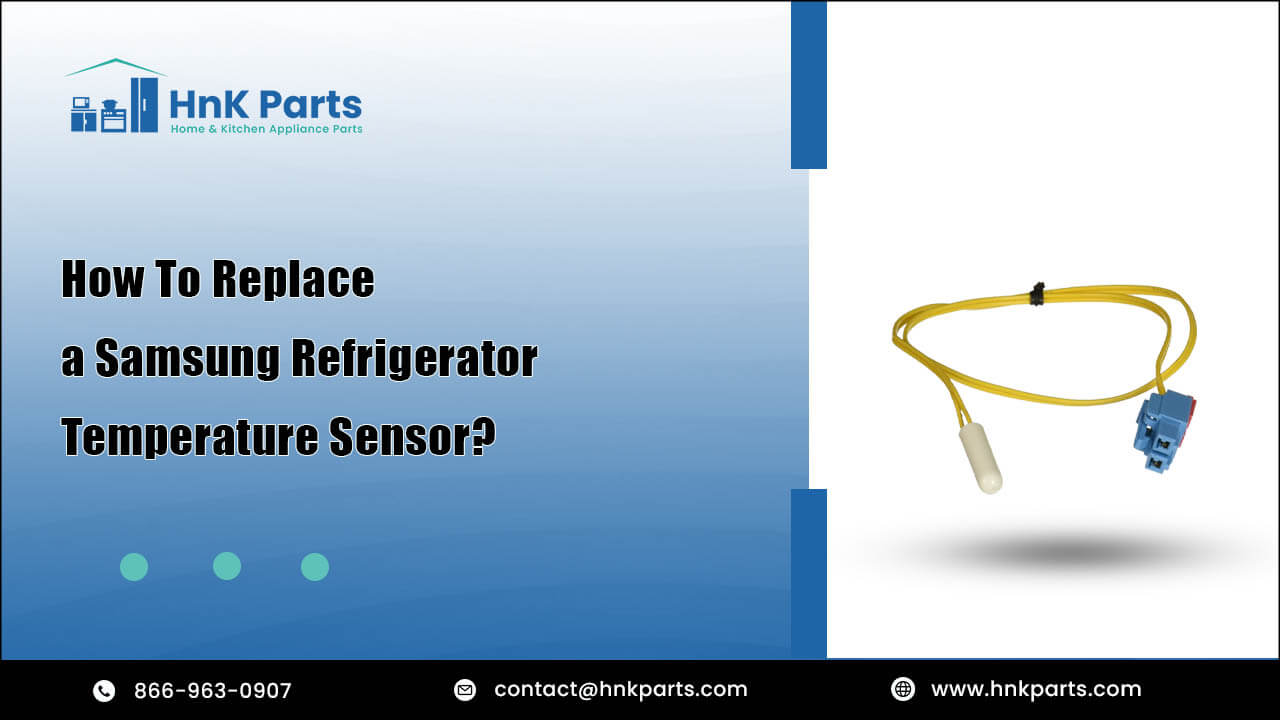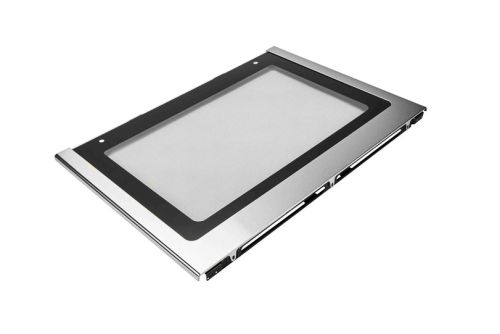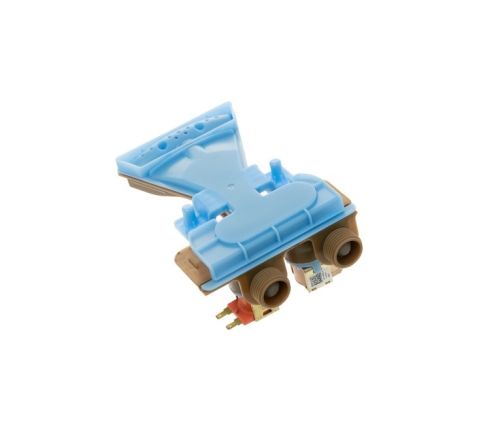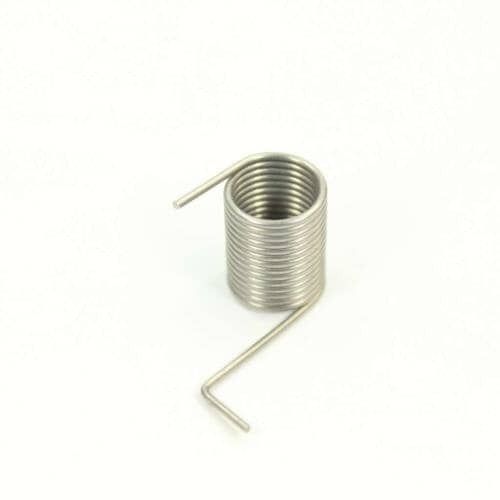
How to Replace a Temperature Sensor for Samsung Refrigerator ?
Maintaining the proper temperature in your refrigerator is critical for preserving the freshness of your foods. If you've noticed temperature variations or your Samsung refrigerator isn't chilling properly, the temperature sensor may need to be replaced. The temperature sensor regulates the internal temperature of the fridge, ensuring that your food stays fresh for a longer time. Replacing the temperature sensor in a Samsung refrigerator is a straightforward task that you can complete yourself with the proper tools and instructions. We'll know how to replace temperature sensor in your refrigerator parts, restore its cooling effectiveness, and keep your food fresh.
| Table of Contents: What is the function of a temperature sensor in a refrigerator? Common signs of a faulty samsung refrigerator temperature sensor Tools required for the samsung temperature sensor replacement Safety precautions should be taken before starting the repair process Replacement guide for samsung refrigerator temperature sensor Testing the replacement of samsung refrigerator temperature sensor |
What is the function of a temperature sensor in a refrigerator?
The function of a temperature sensor in a refrigerator is to monitor and regulate the internal temperature of the appliance. measures the temperature inside the refrigerator to ensure it remains within the desired range for optimal food storage. Based on the temperature readings, the sensor signals the refrigerator's cooling system to adjust the compressor operation, fan speed, or defrost cycle to maintain the set temperature. By accurately sensing temperature variations, the sensor helps to ensure that perishable foods are stored at the correct temperature to extend their shelf life and maintain freshness. Keeping the refrigerator at the ideal temperature helps prevent foodborne illnesses by inhibiting the growth of harmful bacteria that thrive in warmer temperatures. Proper operation of the temperature sensor contributes to the refrigerator's energy efficiency by preventing unnecessary cooling cycles and reducing energy consumption. Temperature sensors can also detect fluctuations or anomalies in temperature, signaling potential issues within the refrigeration system that may require maintenance or repair.
Know more about How to Change Water Filter on Samsung Refrigerator
Common signs of a faulty samsung refrigerator temperature sensor
Some common signs of a faulty temperature sensor in a Samsung refrigerator may include:
- Inaccurate temperature readings: If the refrigerator displays inconsistent or incorrect temperatures, it could indicate a faulty temperature sensor. This may lead to food either freezing or not being properly chilled.
- Spoilage or freezing of food: Fluctuating temperatures, often caused by a faulty sensor, can result in premature food spoilage or freezing within the refrigerator compartments.
- Frost build-up: If the temperature sensor is malfunctioning, it may lead to improper defrost cycles, causing excessive frost buildup in the freezer compartment or on the evaporator coils.
- Inconsistent cooling: A faulty temperature sensor may cause the refrigerator to have difficulty maintaining the correct temperature, leading to inconsistent cooling throughout the appliance.
- Excessive cooling or lack of cooling: The refrigerator may run excessively or not enough due to inaccurate temperature readings from a faulty sensor, resulting in high energy consumption or inadequate cooling.
- Error codes: Some Samsung refrigerators may display error codes related to temperature sensor malfunctions, signaling the need for maintenance or replacement.
Know more about How to Set Temperature on Samsung Refrigerator
Tools required for the samsung temperature sensor replacement
The tools required for replacing the temperature sensor in a Samsung refrigerator may vary depending on the specific model and type of refrigerator. However, typical tools that may be necessary for this task include:
- Screwdriver set: A set of Phillips and flathead screwdrivers for removing screws and accessing the interior components of the refrigerator.
- Pliers: To assist in gripping and maneuvering various components during the replacement process.
- Work gloves: To protect your hands during the replacement and handling of components.
- Flashlight: For better visibility inside the refrigerator and to assist in identifying and accessing the temperature sensor.
- Replacement sensor: Ensure you have the correct replacement temperature sensor designed for your specific Samsung refrigerator model.
Safety precautions should be taken before starting the repair process
Before starting the repair process to replace the temperature sensor in your Samsung refrigerator, it is essential to take the following safety precautions:
- Power off: Unplug the refrigerator from the power outlet to avoid the risk of electric shock during the repair process.
- Empty the refrigerator: Remove all food items from the refrigerator to prevent spoilage, contamination, or damage during the repair.
- Wear safety gear: Use appropriate safety gear such as work gloves and safety goggles to protect your hands and eyes when handling components or tools.
- Proper ventilation: Ensure the area where you are working is well-ventilated to prevent the buildup of fumes or odors from cleaning agents or refrigerants.
- Stable work surface: Work on a stable and level surface to prevent accidents or damage to the refrigerator during the repair.
- Follow guidelines: Refer to the product manual or manufacturer's instructions for specific safety guidelines and procedures relevant to your refrigerator model.
- Seek professional help: If you are unsure about performing the repair or lack experience with appliance repairs, it is advisable to seek assistance from a qualified technician to prevent accidents or further damage to the appliance.
Read more Samsung Refrigerator Ice Maker Not Making Ice: Troubleshooting Solutions
Replacement guide for samsung refrigerator temperature sensor
Refrigerator Temperature Sensor
- Locate the sensor: Identify the location of the refrigerator temperature sensor within the refrigerator. The product manual for your Samsung refrigerator should contain detailed information on the sensor's placement.
- Remove the panel: Depending on the model, you may need to remove the interior panels or covers to access the sensor. Use the appropriate screwdriver to remove any screws holding the panels in place.
- Disconnect the sensor: Once the sensor is accessible, disconnect it from the wiring harness. Avoid forceful tugging, and carefully follow the specific removal instructions provided in the product manual.
- Install the new sensor: Install the new temperature sensor by connecting it to the wiring harness in the same manner as the old sensor. Ensure a secure and proper connection.
- Reassemble the panels: Put back any interior panels or covers that were removed to access the sensor, and fasten them securely with the screws.
- Plug In the refrigerator: After the replacement is complete, plug the refrigerator back into the power outlet.
Testing the replacement of samsung refrigerator temperature sensor
Test the refrigerator to ensure that the new temperature sensor is functioning correctly and that the refrigerator is maintaining the proper temperature and checking for any error codes or malfunctions
Monitoring the refrigerator's temperature after replacement:
Use a thermometer to monitor the temperature in both the refrigerator and freezer compartments. Check periodically over the next 24-48 hours to ensure that the temperatures remain consistent and are within the recommended ranges for food storage. It's important to allow some time for the refrigerator to stabilize after any repairs.Keep an eye on the freshness and condition of the food stored in your refrigerator. If the temperature sensor replacement was successful, the food should be properly chilled without freezing or spoiling prematurely.
Checking for any error codes or malfunctions:
Periodically check the refrigerator's display panel, if available, to ensure that there are no error codes or warning messages related to temperature sensor malfunctions. If you notice any error codes, refer to the manual or contact Samsung customer support for guidance. Monitor the freezer compartment to ensure that there is no excessive frost build-up, which could indicate issues with the defrost cycle affected by the temperature sensor.
Read more 9 Most Common Refrigerator Problems And How To Fix Them?
Maintenance tips for samsung refrigerator temperature sensor
Regularly clean the area surrounding the temperature sensor to prevent the accumulation of dust or debris, which could affect its accuracy. If you notice any temperature inconsistencies or if the refrigerator's internal thermometer does not match the actual temperature, consider calibrating the temperature sensor as per the manufacturer's guidelines. Regularly inspect the temperature sensor and its wiring for any signs of damage, wear, or loose connections. Address any issues promptly to maintain accurate temperature readings. To ensure proper airflow and temperature distribution, avoid overloading the refrigerator with food items, as this can impact the sensor's ability to maintain consistent temperatures. Ensure that the refrigerator is connected to a stable power source to prevent voltage fluctuations that may affect the temperature sensor's operation. Check and maintain the seals on the refrigerator doors to prevent air leaks, which can impact the sensor's ability to maintain consistent temperatures.
Replacing a faulty temperature sensor in your Samsung refrigerator is a straightforward process that can help restore optimal cooling performance and prevent food spoilage. By following the steps in this guide and adhering to safety precautions, you can ensure a smooth and successful replacement. If you have problems with the Samsung refrigerator temperature sensor, consider HnKParts, which provides an extensive selection of Samsung refrigerator parts to meet your needs.
FAQs
How do I know if my Samsung refrigerator temperature sensor needs replacement?
Look out for signs such as temperature fluctuations, inaccurate readings, or unusual noises coming from the refrigerator.
Where is the temperature sensor located in a typical Samsung refrigerator?
The sensor is usually located near the evaporator coils or within the refrigerator compartment. Refer to your user manual for specific details.
How often should I replace the temperature sensor in my Samsung refrigerator?
It depends on usage and environmental factors. Regular maintenance checks can help identify when replacement is necessary.
Will replacing the temperature sensor solve temperature inconsistency issues in my refrigerator?
Yes, a faulty temperature sensor can contribute to temperature inconsistencies, and replacing it can help resolve these issues.
How long does it take to replace a Samsung refrigerator temperature sensor?
The replacement process typically takes about 30 minutes to an hour, depending on your familiarity with appliance repair and the complexity of your refrigerator model.














